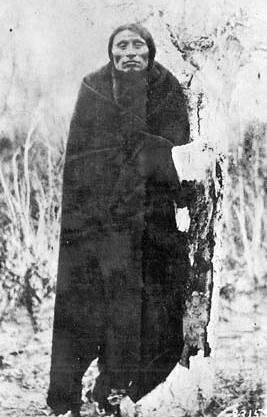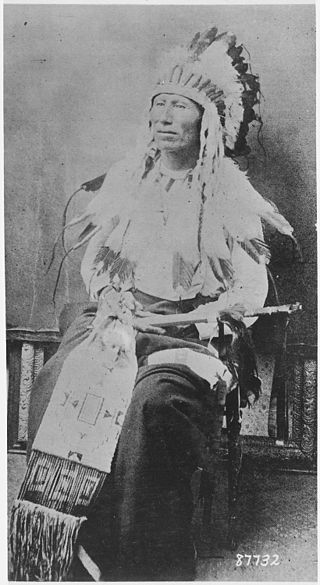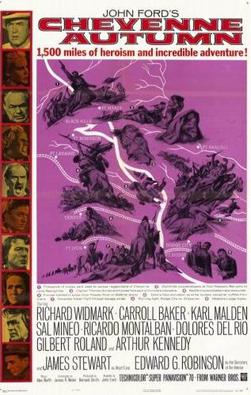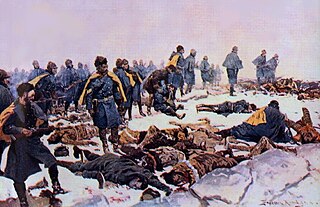
The Cheyenne are an Indigenous people of the Great Plains. The Cheyenne comprise two Native American tribes, the Só'taeo'o or Só'taétaneo'o and the Tsétsêhéstâhese ; the tribes merged in the early 19th century. Today, the Cheyenne people are split into two federally recognized nations: the Southern Cheyenne, who are enrolled in the Cheyenne and Arapaho Tribes in Oklahoma, and the Northern Cheyenne, who are enrolled in the Northern Cheyenne Tribe of the Northern Cheyenne Indian Reservation in Montana. The Cheyenne language belongs to the Algonquian language family.

The Dog Soldiers or Dog Men are historically one of six Cheyenne military societies. Beginning in the late 1830s, this society evolved into a separate, militaristic band that played a dominant role in Cheyenne resistance to the westward expansion of the United States in the area of present-day Kansas, Nebraska, Colorado, and Wyoming, where the Cheyenne had settled in the early nineteenth century.

Little Wolf was a Northern Só'taeo'o Chief and Sweet Medicine Chief of the Northern Cheyenne. He was known as a great military tactician and led a dramatic escape from confinement in Oklahoma back to the Northern Cheyenne homeland in 1878, known as the Northern Cheyenne Exodus.

The Sioux Wars were a series of conflicts between the United States and various subgroups of the Sioux people which occurred in the later half of the 19th century. The earliest conflict came in 1854 when a fight broke out at Fort Laramie in Wyoming, when Sioux warriors killed 31 American soldiers in the Grattan Massacre, and the final came in 1890 during the Ghost Dance War.
The Dull Knife Fight, or the Battle on the Red Fork, part of the Great Sioux War of 1876, was fought on November 25, 1876, in present-day Johnson County, Wyoming between soldiers and scouts of the United States Army and warriors of the Northern Cheyenne. The battle essentially ended the Northern Cheyennes' ability to continue the fight for their freedom on the Great Plains.

Morning Star was a great chief of the Northern Cheyenne people and headchief of the Notameohmésêhese band on the northern Great Plains during the 19th century. He was noted for his active resistance to westward expansion and the United States federal government. It is due to the courage and determination of Morning Star and other leaders that the Northern Cheyenne still possess a homeland in their traditional country in present-day Montana.

Cheyenne Autumn is a 1964 American epic Western film starring Richard Widmark, Carroll Baker, James Stewart, and Edward G. Robinson. It tells the story of a factual event, the Northern Cheyenne Exodus of 1878–79, told with artistic license. The film was the last Western directed by John Ford, who proclaimed it an elegy for the Native Americans who had been abused by the U.S. government and misrepresented in numerous of his own films. With a budget of more than $4 million, the film was relatively unsuccessful at the box office and failed to earn a profit for Warner Bros.

The Northern Cheyenne Tribe of the Northern Cheyenne Indian Reservation is the federally recognized Northern Cheyenne tribe and a Plains tribe.

The Battle of Wolf Mountain was fought on January 8, 1877, by soldiers of the United States Army against Lakota Sioux and Northern Cheyenne warriors during the Great Sioux War of 1876. The battle was fought in southern Montana Territory, about four miles southwest of modern-day Birney, Montana, along the Tongue River.

The Great Sioux War of 1876, also known as the Black Hills War, was a series of battles and negotiations that occurred in 1876 and 1877 in an alliance of Lakota Sioux and Northern Cheyenne against the United States. The cause of the war was the desire of the US government to obtain ownership of the Black Hills. Gold had been discovered in the Black Hills, settlers began to encroach onto Native American lands, and the Sioux and the Cheyenne refused to cede ownership. Traditionally, American military and historians place the Lakota at the center of the story, especially because of their numbers, but some Native Americans believe the Cheyenne were the primary target of the American campaign.

Ledger art is narrative drawing or painting on paper or cloth, predominantly practiced by Plains Indian, but also from the Plateau and Great Basin. Ledger art flourished primarily from the 1860s to the 1920s. A revival of ledger art began in the 1960s and 1970s. The term comes from the accounting ledger books that were a common source of paper for Plains Indians during the late 19th century.
The Cheyenne and Arapaho Tribes are a united, federally recognized tribe of Southern Arapaho and Southern Cheyenne people in western Oklahoma.

The Fort Robinson breakout or Fort Robinson massacre was the attempted escape of Cheyenne captives from the U.S. army during the winter of 1878-1879 at Fort Robinson in northwestern Nebraska. In 1877, the Cheyenne had been forced to relocate from their homelands on the northern Great Plains south to the Darlington Agency on the Southern Cheyenne Reservation in Indian Territory (Oklahoma). In September 1878, in what is called the Northern Cheyenne Exodus, 353 Northern Cheyenne fled north because of poor conditions on the reservation. In Nebraska, the U.S. Army captured 149 of the Cheyenne, including 46 warriors, and escorted them to Fort Robinson.
Little Shield was a chieftain of the Northern Cheyenne from 1865–1879. He is known for creating a collection of ledger drawings accounting the Indian wars along the North Platte river. Little Shield also fought in the Battle of Little Bighorn, leading the Dog Soldiers.

The Battle of Punished Woman's Fork, also called Battle Canyon, was the last battle between Native Americans (Indians) and the United States Army in the state of Kansas. In the Northern Cheyenne Exodus, 353 Cheyenne, including women and children, fled their reservation in Oklahoma in an attempt to return to their homeland on the northern Great Plains. In Kansas, they fought soldiers of the U.S. Army at Punished Woman's Fork, killing the army commander. After the battle the Cheyenne continued northward. Some were successful in reaching their relatives in Montana. Others were captured or killed near Camp Robinson, Nebraska.

Porcupine was a Cheyenne chief and medicine man. He is best known for bringing the Ghost Dance religion to the Cheyenne. Raised with the Sioux of a Cheyenne mother, he married a Cheyenne himself and became a warrior in the Cheyenne Dog Soldiers.
Cheyenne Autumn Trail is a 19-minute live action American film produced in color for distribution in late 1964, with narration by James Stewart. Structured as a complementary social and historical companion piece to John Ford's final western, Cheyenne Autumn, it intersperses clips from the big-screen epic with background information about the Northern Cheyenne Exodus of 1878–79 and contrasts it with life on the Cheyenne reservation in 1964, as a tribal chief, a tribal beauty queen and a tribal adolescent take a drive along the route of the 19th-century trek.

Wo’óoseinee’, known commonly as Black Coal, (c.1840-1893) was a prominent leader of the Northern Arapaho people during the latter half of the 19th Century. Serving as an intermediary between the Northern Arapaho and the United States, he helped lead the transition from free-roaming life and armed resistance to American expansion, to alliance and eventual settlement alongside the Eastern Shoshone at today's Wind River Indian Reservation.

The Battle of Turkey Springs was the last battle between Native Americans (Indians) and the United States Army in the state of Oklahoma. In the Northern Cheyenne Exodus, 353 Cheyenne Indians, fleeing their reservation in Oklahoma in an attempt to return to their homeland in the northern Great Plains, fought a unit of the United States Army, killing three soldiers. After the battle the Cheyenne continued northward skirmishing with the army along the way. Some were successful in reaching their relatives in Montana. Others were captured or killed near Camp Robinson, Nebraska.

The murder trial of seven Cheyenne took place in 1879 in Dodge City and Lawrence, Kansas. Seven Native American (Indian) warriors were accused of killing 40 civilians in Decatur County, Kansas. The killings took place during the Northern Cheyenne Exodus in which 353 Cheyenne men, women, and children fled their reservation in Indian Territory and attempted to return to their homeland on the northern Great Plains. The imprisonment and trial of the seven Cheyenne took place over a period of eight months and was widely publicized and controversial. A judge concluded the trial by dismissing the murder charges on the seven. The Ledger art created by several of the Cheyenne while imprisoned is preserved in museums.


















